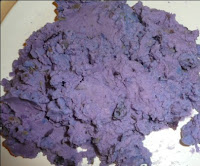Wondering what you can cook with "in-season, Northwest" produce in February? Here is what's in our oven: root crops that have stayed in the ground all winter (carrots and parsnips) and others that have been stored all winter (potatoes, onions and garlic). The result: a beautiful bouquet of roasted vegetables. It's one of the more easy way we prepare vegetables. Chop a variety of vegetables as close to the same size as possible. Drizzle with olive oil and sprinkle with a little salt and pepper or your favorite seasoning, if desired. Mix in a 9x13 pan and roast in the oven at 400 degrees for about an hour, depending on the size the pieces. Stir occasionally to ensure even roasting and to keep them from sticking to the pan. Test with fork for tenderness to check if they are done.
I have also decided I am not good at taking pictures of prepared meals (I'm better at capturing the produce while it's still in the field or on the vine), but I had to include another winter veggie we prepared the other night: purple mashed potatoes. This summer when you're at the farmer's market, get adventurous! Pick up something you've never made before- or something that is a different color than what you are comfortable with. Then have some fun! Purple mashed potatoes are prepared the same way you make any mashed potatoes, just use a colored potato. Technically, these were blue potatoes, but they appear more purple. Happy experimenting! Just think of the fun things you could make- purple hash browns, french fries, potato pancakes...
February 23, 2011
February 17, 2011
Seed Time!
Hello, UPS truck! The boxes of seed packets are arriving! We have been fielding the question "so, what are you guys doing on the farm right now?" Our answer this week: "planting!" In February, this is usually met with a surprised expression, but in fact, we are "behind" on some of the outdoor planting already. With the threat of freezing temps this weekend, though, this will wait for a little while. There is no typical schedule, since the weather varies so much, but Vince has created his "ideal calendar" and then records when he actually plants each crop. He has been studying seed catalogs and working on his orders and now the seeds are starting to arrive in the mail. Vince tries to order them from local companies, but it is struggle to get a good value for the amount we need. We need more than if we were to buy packets from the local co-op or hardware store, but not the volume required when ordering in bulk amounts designed for the very large farms. Decisions were made and now that seeds have arrived, the tedious job of planting seeds for starts indoors begins!
This year he added full length mirrors above the trays to focus the grow lights more efficiently.
This year he added full length mirrors above the trays to focus the grow lights more efficiently.
 |
| Mirrors attached to the sides of the grow lights. |
February 14, 2011
Valentine Cactus
I can grow something indoors! While Vince is such a great gardener, I (Anna) can never seem to keep a house plant alive. Mostly due to neglect and inconsistent watering, I imagine. We have had this Christmas Cactus for a number of years now, but I have only seen it bloom once. This year, it is closer to a Valentine Cactus than Christmas, but it is still exciting to see the bright blooms, no matter what time of year it is, especially during the characteristically dark winter.
February 11, 2011
The Chicken Coop Papers
There will be no more "bird brains" around this farm anymore. Our birds will be well-read, educated chickens. In our never-ending effort to reuse materials to keep our costs down as well as recycle, we have started using shredded paper in their coops. When you have access to a large bag of shredded paper every day, this is easy (and free), not to mention, environmentally friendly. It's even easier when you become known as the "egg lady" at work so people start looking for ways to help you. Hence the piles of egg cartons on my desk each afternoon and the offerings of more shredded paper from households far and wide. All it took was one day of walking down the hall carrying my bag of shredded paper. In the winter the chicken yards can get pretty muddy, no matter how often we move them, and muddy yards equal dirty eggs. Shavings work well, but can get expensive. We have also tried straw, but they drag it out of the boxes into the coop. Straw also hides the eggs when the chickens try to nest so the egg gatherer has to sift through it to find them. Paper mixed in with the shavings is our new trial. As long as we can keep the chickens from putting together these classified documents...
Subscribe to:
Posts (Atom)





